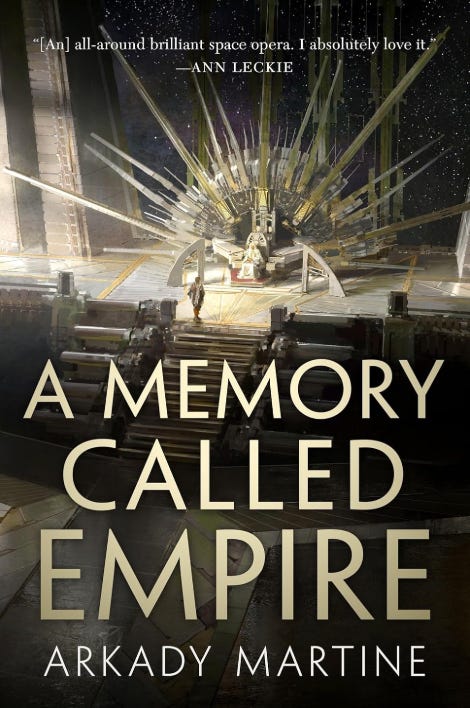Note: This is an older review to introduce Substackers to our house style (TCTIN). A majority of the books we review will be advanced review copies (ARCs) given to our parent companies, everafterbooks.uk and theubergroup.org.
The coolest thing I noticed about the science fiction novel A Memory Called Empire was how it uses exotic, mind-altering technology to make its main character (Mahit) seem more human and relatable, rather than less (minor spoilers follow).
In the far future, the vast human empire of Teixcalaan has spread to the stars and survived for thousands of years, thanks to ruthless military expansion, advanced technology, and faster-than-light travel. Along the way the Teixcalaanli have developed a rich culture steeped in poetry, literature, and exotic cuisine. They even encrypt their equivalent of email using verse. The seat of the empire’s power — The Jewel of the World — is a vast, planet-spanning city. The future, in other words, is very bright.
Mahit is an ambassador from Lsel, a small, independent mining station on the edge of Teixcalaanli space, a station that would very much like to stay independent. Mahit’s people have their own language, culture, and everything else, and fear the empire will consume these the way it has so many other things. And they have good reason to fear this, since many people on Lsel, Mahit included, love Teixcalaan culture, because of course they would — life on a space station with only a few thousand people isn’t all that exciting.
Mahit’s affection for Teixcalaan is partly why she trains to be an ambassador, but her training is cut short when she’s unexpectedly summoned to the empire because her predecessor, Yskandr, has died. Within weeks Mahit’s on her own in the Jewel of the World, fighting for Lsel’s sovereignty, dodging attempts on her life, and up to her neck in interstellar intrigue.
To make all this be understandable, I’d expect a story like this to hit the reader with distracting prologues and introductory chapters. But a Memory Called Empire has a secret — or, rather, Mahit does. A technology in her brain called an imago machine, hosting a fully functional, backed-up copy of Yskandr’s personality. And Mahit can converse with Yskandr silently, which is a good thing because not only do the Teixcalaanli not have imago machines, but mind-altering technology is outlawed in the empire.
Thanks to Mahit’s imago machine and her copy of Yskandr’s personality, she at least has a shot at navigating the empire’s many bureaucratic, cultural, and real life dangers. This allows Mahit to appear outwardly competent and composed while being anything but on the inside. This also helps her seem more sympathetic without sacrificing realism.
Yskandr’s imago-hosted personality is a little better off, but he’s not perfect, since he’s years out of date. This means that both he and Mahit are equally clueless about what the flesh-and-blood version of Yskandr was up to before his death. And since the pair were thrown together so quickly, they often (again, silently) disagree, and their agendas don’t align until late in the story.
This imago technology allows for a parallel narrative alongside the real-life action in the story, while adding an extra layer of tension between Mahit and Yskandr. And through Mahit and Yskandr’s interactions, I had the chance to learn about Teixcalaan as Mahit experienced it, without time-consuming introductions or asides. An additional benefit of Mahit being thrust so quickly into this strange environment is not having to know anything about Lsel, Mahit, or Yskandr’s upbringing until these things naturally became more important later in the story.
When I learned about these aspects, however, I was surprised to find the imago machine had another role to play: imago machines are how Lsel station passes the expertise of its relatively few miners, pilots, and other specialists from one generation to the next, forming imago “lines” that extend for centuries. While technically interesting, the real value of this was to show how different Teixcalaan and Lsel are beneath the surface, and that neither represents a definitive version of how to survive in an unforgiving universe.
In summary, while the imago machine may be tiny, it’s a powerful tool for immersing readers in such a rich and complex world. Brain-altering technology has been a staple of science fiction for a long time, but it mostly seems to make characters less human and, therefore, less relatable. But A Memory Called Empire and its imago machines flip this script effectively, making Mahit and her world more understandable, believable and, ultimately, more enjoyable.



Thanks! I may give this a read!